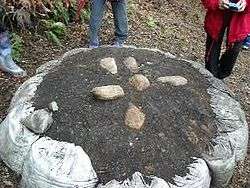Isedōtai site
The Isedōtai ruins (伊勢堂岱遺跡, Isedōtai iseki) is a late Jōmon period archaeological site in the city of Kitaakita, Akita Prefecture, in the Tōhoku region of northern Japan. Discovered during the construction of a highway to nearby Odate–Noshiro Airport, the remains were designated a National Historic Site of Japan in 2001 by the Japanese government. The site is located approximately five minutes on foot from Ogata on the Akita Nairiku Railway.
伊勢堂岱遺跡 | |
Placard at Isedōtai ruins | |
 Isedōtai ruins  Isedōtai site (Japan) | |
| Region | JP |
|---|---|
| Coordinates | 40°12′04″N 140°20′53″E |
| Type | landmark |
| Area | 200,000 square metres (2,200,000 sq ft) |
| History | |
| Founded | 2000 BCE |
| Periods | Jōmon period |
| Site notes | |
| Public access | Yes |
Site
The site consists of three large stone circles located on an artificially flattened plateau on the west bank of the Yoneshiro River. The largest circle is between 42 and 45 meters in diameter, and completely encloses a fourth stone circle. The stones, including porphyrite, rhyolite and tuff, were brought from rivers up to five kilometers away, and the site has a moat on its eastern side with a length of more than 100 meters. More than 100 pits have been found, both inside and outside the stone circles, containing terracotta plates and jars, and small clay objects along with hunting and fishing implements and everyday tools. No bones have been found, but soil discoloration indicates that the site was a necropolis and the objects found were ritual or grave-goods.[1] Some 200 clay dogu have also been found on the site, many of which appear to have been intentionally broken. One of the stone circles contains a standing stone which appears to have served as a sun dial.

Next to the stone circles, post holes indicate that as many as 37 pit-houses with a width of 3–5 meters and length of 6–7 meters were built on the site, although there is no indication that this was a permanently inhabited settlement.
There are no public facilities at site. Many of the artifacts recovered from the site are on display at the Kitaakita city Community Center.[2]
The site has been submitted for inscription on the UNESCO World Heritage List as one of the Jōmon Archaeological Sites in Hokkaidō, Northern Tōhoku, and other regions[3][4]
References
- Naumann, Nelly (2000). Japanese Prehistory: The Material and Spiritual Culture of the Jōmon Period. Asien-und Afrika-Studien der Humboldt-Universitat zu Berlin (Book 6). Harrassowitz Verlag. p. 38. ISBN 3447043296.
- "Isedotai Site". Jomon Archaeological Sites in Hokkaido and Northern Tohoku. Jomon Japan. 2015. Retrieved 23 December 2015.
- "Jômon Archaeological Sites in Hokkaidô, Northern Tôhoku, and other regions". UNESCO. Retrieved 19 June 2012.
- 「北海道・北東北を中心とした縄文遺跡群」の世界文化遺産登録をめざして [Towards World Heritage Inscription of "Jōmon Archaeological Sites in Hokkaidō, Northern Tōhoku, and other regions"] (in Japanese). Hokkaidō Government Board of Education. Archived from the original on 8 May 2013. Retrieved 9 November 2013.
External links
![]()
- 伊勢堂岱遺跡 Agency for Cultural Affairs (Japanese)